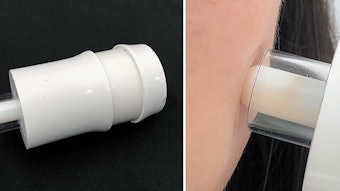
Read the full article in the January 2021 digital edition. . .
The integumentary system is more than just a barrier between our bodies and the environment. It is a vast sensory organ, designed to collect palpable information from one's surroundings; such as the warm feeling of sunshine on your face; the comfort of the chair you are sinking into; or even the softness and pleasure you experience while stroking your pet's fur.
These are just a few examples of the nearly endless list of pleasurable sensations humans can enjoy through the sense of touch. However, there is a flip-side to this—and it is not so pleasant. As we go about our daily lives, we come into contact with elements of our environment that can be hazardous and damaging to the body: extremely hot pans from the oven; sharp knives in the silverware drawer; or even insect stings. These noxious stimuli are associated with feelings of pain or itch, which serves as a harsh warning for the body to get away from the source of that stimuli. In the skin, noxious stimuli are relayed by nociceptive sensory neurons such as C-fibers and Ad-fibers.1 These neurons, which have their cell body in the dorsal root ganglia next to the spine, send out nerve fibers whose free nerve endings terminate within the granular or spinous layer of the epidermis.2 Traditional views of the cutaneous nociceptive system have long held that these sensory nerves were the only cells with sensory capabilities in the skin and hence, they are solely responsible for detecting noxious stimuli.3 However, recent studies have indicated this may not be the case.
Within the epidermis, the nociceptive nerve fibers are surrounded by, and are in contact with, the epidermal keratinocytes. It is these keratinocytes that form a small barrier between the nociceptive nerve fibers and the outside. Interestingly, these nerve fibers are unmyelinated in the epidermis (C-fibers are unmyelinated while Ad-fibers lose their myelination when they enter the epidermis), allowing them to come into direct contact with the epidermal keratinocytes.1 This contact is no accident. As it turns out, epidermal keratinocytes express a broad range of sensory proteins. Therefore, in addition to their barrier function, these cells also serve a critical role in transducing environmental stimuli to the epidermal nociceptive nerves.4
Keratinocyte Nociceptive Detection
Both epidermal keratinocytes and epidermal nociceptive sensory nerves use a common family of proteins to detect noxious stimuli. This detection is provided by a class of sensory receptors belonging to the family of Transient Receptor Protein (TRP) ion gates.5 These proteins form channels in the plasma membrane that can react to thermal, mechanical and chemical stimuli and when activated, they allow for the transient entry of calcium into the cell in keratinocytes or membrane depolarization in sensory neurons.6 In keratinocytes, this influx of calcium via activation of the TRPs activates a signaling cascade within the cell to promote the release of a variety of neuroactive substances, including: ATP, calcitonin gene-related peptide (CGRP), epinephrine, acetylcholine and cytokines such as IL-8, IL-1B and PGE2.7
The TRP superfamily has 28 members to it, subdivided into six families: canonical (TRPC), vanilloid (TRPV), melastatin-related (TRPM), ankyrin (TRPA), mucolipin (TRPM) and polycystic (TRPP).5 Of these families, the TRPV family is perhaps the most extensively studied in part due to its temperature-sensitive activation. TRPV1 is known to be activated at temperatures above 42°C.8 TRPV2 is activated at temperatures above 52°C,9 and TRPV3 is activated at temperatures above 33°C to 39°C .6 In addition to thermal inputs, these receptors are polymodal and respond to a wide variety of chemical and physical stimuli. For example, TRPV1 responds to a decrease in local pH and to stimulation with capsaicin, the main ingredient in chili peppers responsible for the "heat" when consumed.5
These types of stimulation result in a transmission of a pain signal initiated by the keratinocyte and then transmitted to the sensory neuron. TRPV1 can also respond to stimuli associated with itch, such as histamine and endothelin-1.10 These types of responses are mediated by the respective ligand binding to its G-protein coupled receptor on the surface of the keratinocyte and activating an intracellular signaling cascade, which can lead to the phosphorylation of the TRP and its subsequent activation.11
The essential role of TRPs in mediating itch and pain responses in the skin would alone make them targets of interest for the skin care industry. However, the effects of the TRPs on keratinocyte function often go beyond merely relaying information from the environment to the sensory neurons. As these TRP channels are associated with an influx of calcium into the keratinocytes, this calcium surge can initiate a series of events within the cell that can respond to the noxious stimulus itself.6 Noted later in this column, sometimes the keratinocytes' cellular response to TRP activation is not beneficial to the cell. Rather, it can be harmful to the keratinocyte and/or to the sensory neurons associated with it. It is the counter-action of some of these adverse effects of TRP activation that could also be of interest to the skin care industry.
UVB Exposure
At least two members of the TRP family respond to UVB light: TRPV4 and TRPC7. With respect to TRPV4, the activation of this ion channel is thought to be responsible for the pain associated with sunburns.12 The mechanism involved with this pain response revolves around the activation of TRPV4 in epidermal keratinocytes, resulting in the production of endothelin-1. Endothelin-1 is the active pain-causing agent, which can unfortunately stimulate further up-regulation of TRPV4.
. . .Read more in the January 2021 digital edition. . .
References
- Talagas, M., et al. (2018). What about physical contacts between epidermal keratinocytes and sensory neurons? Exper Derm 27 9-13.
- Talagas, M., Lebonvallet, N., Berthod, F. and Misery, L. (2020). Lifting the veil on the keratinocyte contribution to cutaneous nociception. Protein and Cell 11(4) 239-250.
- Basbaum, A.I., Bautista, D.M., Scherrer, G. and Julius, D. (2009). Cellular and molecular mechanisms of pain. Cell 139 267-284.
- Hesselink, J.M.K., Kopsky, D.J. and Bhaskar, A.K. (2017). Skin matters! The role of keratinocytes in nociception: a rational argument for the development of topical analgesics. J Pain Res 10 1-8.
- Samanta, A., Hughes, T.E. and Moiseenkopva-Bell, V.Y. (2018, Jul 18). Transient Receptor Potential (TRP) channels. Subcell Biochem 87 141-165. doi:10.1007/978-981-10-7757-9_6.
- Caterina, M.J. and Pang, Z. (2016). TRP channels in skin biology and pathophysiology. Pharma 9(77) 1-28.
- Moehring, F., et al. (2018, Jan 16). Keratinocytes mediate innocuous and noxious touch via ATP-P2X4 signaling. Elifesciences.org. Https://elifesciences.org/articles/31684
- Caterina, M.J., (1997). The capsaicin receptor: a heat-activated ion channel in the pain pathway. Nature 389 816-824.
- Caterina, M.J., Rosen, T.A., Tominaga, M., Brake, A.J. and Julius, D. (1999). A capsaicin-receptor homologue with a high threshold for noxious heat. Nature 398 436-441.
- Talagas, M. and Misery, L. (2019). Role of keratinocytes in sensitive skin. Frontiers in Medicine 6(108). doi: 10.3389/fmed.2019.00108.
- Salzer, I., Ray, S., Schicker, K. and Boehm, S. (2019). Nociceptor signaling through ion channel regulation via GPCRs. Int J Mol Sci 20 248. doi:10.3390/ijms20102488.
- Moore C, et al. (2013). UVB radiation generates sunburn pain and affects skin by activating epidermal TRPV4 ion channels and triggering endothelin-1 signaling. Proc Natl Acad Sci USA. Https://pubmed.ncbi.nlm.nih.gov/23929777/











